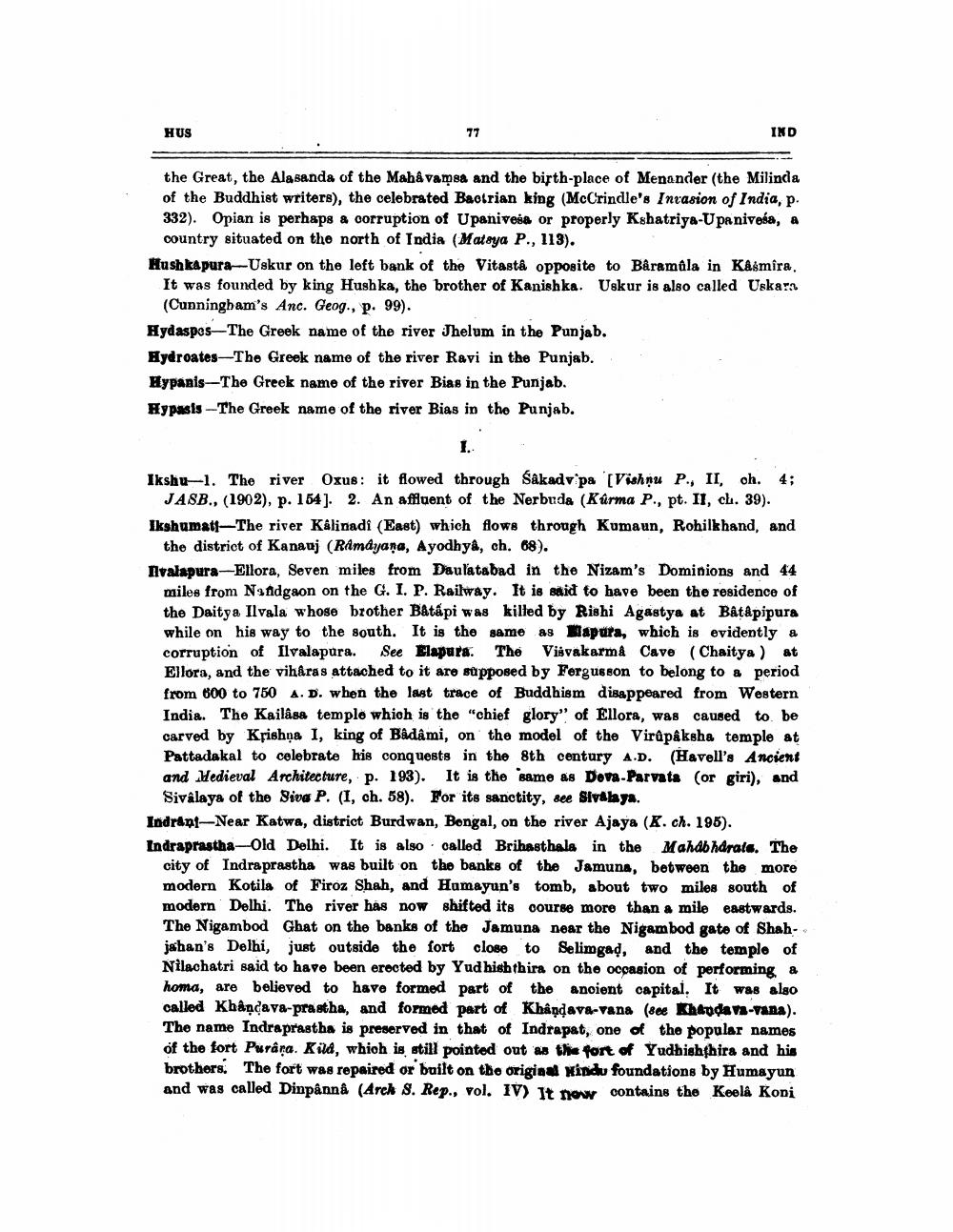________________
HUS
77
IND
the Great, the Alasanda of the Mahavamsa and the birth-place of Menander (the Milinda of the Buddhist writers), the celebrated Baotrian king (McCrindle's Invasion of India, p. 332). Opian is perhaps a corruption of Upanivesa or properly Kshatriya-Upanivesa, a
country situated on the north of India (Matsya P., 113). Hush kapura-Uskur on the left bank of the Vitastå opposite to Baramala in Kasmira,
It was founded by king Hushka, the brother of Kanishka. Uskur is also called Uskars.
(Cunningham's Anc. Geog., p. 99). Hydaspes—The Greek name of the river Jhelum in the Punjab. Hydroates-The Greek name of the river Ravi in the Punjab. Hypanis--The Greek name of the river Bias in the Punjab. Hypasis - The Greek name of the river Bias in the Punjab.
1.
Ikshu-1. The river Oxus: it flowed through Śâkad v pa '[Vishnu P. II, ch. 4;
JASB., (1902), p. 154]. 2. An affluent of the Nerbuda (Kurma P., pt. II, ch. 39). Ikshumatt-The river Kálinadi (East) which flows through Kumaun, Rohilkhand, and
the district of Kanauj (Ramayana, Ayodhya, ch. 68). Nvalapura-Ellora, Seven miles from Daulatabad in the Nizam's Dominions and 44
miles from Nandgaon on the G. I. P. Railway. It is said to have been the residence of the Daitya Ilvala whogo brother Batápi was killed by Rishi Agastya at Bât&pipura while on his way to the south. It is the same as Hapura, which is evidently a corruption of Ilvalapura. See Elapura. The Visvakarma Cave (Chaitya ) at Ellora, and the vihåras attached to it are supposed by Fergusson to belong to a period from 600 to 750 A. D. when the last trace of Buddhism disappeared from Western India. The Kailâsa temple which is the "chief glory of Ellora, was caused to be carved by Krishna 1, king of Badâmi, on the model of the Virûpaksha temple at Pattadakal to celebrate his conquests in the 8th century A.D. (Havell's Ancient and Medieval Architecture, p. 193). It is the same as Dova-Parvata (or giri), and
Sivalaya of the Siva P. (1, ch. 58). For its sanctity, see Sivalaya. Indrant-Near Katwa, district Burdwan, Bongal, on the river Ajaya (K. ch. 195). Indraprastha-Old Delhi. It is also called Brihasthala in the Mahabharata. The
city of Indraprastha was built on the banks of the Jamuna, between the more modern Kotila of Firoz Shah, and Humayun's tomb, about two miles south of modern Delhi. The river has now shifted its course more than a mile eastwards. The Nigambod Ghat on the banks of the Jamuna near the Nigambod gate of Shahjahan's Delhi, just outside the fort close to Selimgad, and the temple of Nilachatri said to have been erected by Yudhishthira on the occasion of performing a homa, are believed to have formed part of the ancient capital. It was also called Khåndava-prastha, and formed part of Khåndave-vans (see Khaodava-vana). The name Indraprastha is preserved in that of Indrapat, one of the popular names of the fort Purára. Kild, which is still pointed out as the fort of Yudhishthira and his brothers. The fort was repaired or built on the original Mindu foundations by Humayun and was called Dinpannå (Arck 8. Rep., vol. IV) It now contains the Keelê Koni




